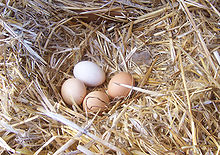Under natural conditions, most birds lay only until a clutch is complete, and they will then incubate all the eggs. Many domestic hens will also do this–and are then said to "go broody". The broody hen will stop laying and instead will focus on the incubation of the eggs (a full clutch is usually about 12 eggs). She will "sit" or "set" on the nest, protesting or pecking in defense if disturbed or removed, and she will rarely leave the nest to eat, drink, or dust-bathe. While brooding, the hen maintains the nest at a constant temperature and humidity, as well as turning the eggs regularly during the first part of the incubation. To stimulate broodiness, an owner may place many artificial eggs in the nest, or to stop it they may place the hen in an elevated cage with an open wire floor.
At the end of the incubation period (about 21 days),[15] the eggs, if fertile, will hatch. Development of the egg starts only when incubation begins, so they all hatch within a day or two of each other, despite perhaps being laid over a period of two weeks or so. Before hatching, the hen can hear the chicks peeping inside the eggs, and will gently cluck to stimulate them to break out of their shells. The chick begins by "pipping"; pecking a breathing hole with its egg tooth towards the blunt end of the egg, usually on the upper side. The chick will then rest for some hours, absorbing the remaining egg yolk and withdrawing the blood supply from the membrane beneath the shell (used earlier for breathing through the shell). It then enlarges the hole, gradually turning round as it goes, and eventually severing the blunt end of the shell completely to make a lid. It crawls out of the remaining shell, and its wet down dries out in the warmth of the nest.
The hen will usually stay on the nest for about two days after the first egg hatches, and during this time the newly hatched chicks live off the egg yolk they absorb just before hatching. Any eggs not fertilized by a rooster will not hatch, and the hen eventually loses interest in these and leaves the nest. After hatching, the hen fiercely guards the chicks, and will brood them when necessary to keep them warm, at first often returning to the nest at night. She leads them to food and water; she will call them to edible items, but seldom feeds them directly. She continues to care for them until they are several weeks old, when she will gradually lose interest and eventually start to lay again.
Modern egg-laying breeds rarely go broody, and those that do often stop part-way through the incubation. However, some "utility" (general purpose) breeds, such as the Cochin, Cornish and Silkie, do regularly go broody, and they make excellent mothers, not only for chicken eggs but also for those of other species—even those with much smaller or larger eggs and different incubation periods, such as quail, pheasants, turkeys or geese. Chicken eggs can also be hatched under a broody duck, with varied success.





 Acc. No. : 133-00-87020-9
a. n : jaka susanto
Acc. No. : 133-00-87020-9
a. n : jaka susanto
 Acc. No. : 122-00-087020-8
a. n : siti juberdahg
Acc. No. : 122-00-087020-8
a. n : siti juberdahg
 dani
dani  andang
andang
0 komentar:
Posting Komentar